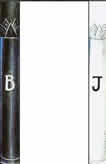 ©1990 by U.S. Games Systems, Inc
©1990 by U.S. Games Systems, Inc Today we're going to explore the abundance of symbols within the enigmatic High Priestess Tarot card from the Rider-Waite-Smith tradition.
 Number 2 – Balance; Yin/Yang; Opposites Unified (Taoism); "Good Things Comes in Pairs" (Chinese philosophy); Diversity (Pythagoras); Potential for Disorder/Evil (Pythagoras); Balance; Duality; Opposition
Number 2 – Balance; Yin/Yang; Opposites Unified (Taoism); "Good Things Comes in Pairs" (Chinese philosophy); Diversity (Pythagoras); Potential for Disorder/Evil (Pythagoras); Balance; Duality; Opposition
 Black and White Pillars – As the number 2, black and white signifies duality—yin/yang, dark/light, feminine/masculine, severity/mercy, passive/aggressive, esoteric/exoteric, heart/mind, intuition/logic and so on. Toggling back and forth, they are "either/or". However, the central veil featuring pomegranates and the date palm tree connects the two pillars—suggesting integration and the union of opposites. The two pillars, when joined by the veil, signify "both".
Black and White Pillars – As the number 2, black and white signifies duality—yin/yang, dark/light, feminine/masculine, severity/mercy, passive/aggressive, esoteric/exoteric, heart/mind, intuition/logic and so on. Toggling back and forth, they are "either/or". However, the central veil featuring pomegranates and the date palm tree connects the two pillars—suggesting integration and the union of opposites. The two pillars, when joined by the veil, signify "both".
B and J – In I Kings 7 (Old Testament), the author offers a detailed description of Solomon's temple, including the pillars that marked the entrance. Verse 21 states: "Then he set up the pillars by the vestibule of the temple; he set up the pillar on the right and called its name Jachin, and he set up the pillar on the left and called its name Boaz." (NKJV) In Hebrew, Jachin means "He Shall Establish", while Boaz means "In It Is Strength".





 What is an archetype? An archetype is a template or original pattern from which copies are made. Psychologist Carl Jung, author Joseph Campbell, storyteller/author Clarissa Pinkola Estes, psychologist Jean Shinonda-Bolen and others are among those that have brought the concept of Archetypes into our consciousness.
What is an archetype? An archetype is a template or original pattern from which copies are made. Psychologist Carl Jung, author Joseph Campbell, storyteller/author Clarissa Pinkola Estes, psychologist Jean Shinonda-Bolen and others are among those that have brought the concept of Archetypes into our consciousness. 
 Number 2 – Balance; Yin/Yang; Opposites Unified (Taoism); "Good Things Comes in Pairs" (Chinese philosophy); Diversity (Pythagoras); Potential for Disorder/Evil (Pythagoras); Balance; Duality; Opposition
Number 2 – Balance; Yin/Yang; Opposites Unified (Taoism); "Good Things Comes in Pairs" (Chinese philosophy); Diversity (Pythagoras); Potential for Disorder/Evil (Pythagoras); Balance; Duality; Opposition Black and White Pillars – As the number 2, black and white signifies duality—yin/yang, dark/light, feminine/masculine, severity/mercy, passive/aggressive, esoteric/exoteric, heart/mind, intuition/logic and so on. Toggling back and forth, they are "either/or". However, the central veil featuring pomegranates and the date palm tree connects the two pillars—suggesting integration and the union of opposites. The two pillars, when joined by the veil, signify "both".
Black and White Pillars – As the number 2, black and white signifies duality—yin/yang, dark/light, feminine/masculine, severity/mercy, passive/aggressive, esoteric/exoteric, heart/mind, intuition/logic and so on. Toggling back and forth, they are "either/or". However, the central veil featuring pomegranates and the date palm tree connects the two pillars—suggesting integration and the union of opposites. The two pillars, when joined by the veil, signify "both".










